Valdez Contrasts
The Captain had successfully avoided several icebergs, both visible and on radar. He’d had to go outside normal shipping channels to do so, but he had radio-contacted shipping dispatch, and all traffic in the area was being handled safely. Leaving the big ship on autopilot, he gave instructions to a subordinate to steer the ship back to normal lanes, after passing a well-known beacon.
The subordinate, who incidentally was not rated to pilot the ship in that area, tried to turn the huge vessel but was having problems. The autopilot was still engaged, and was over-riding the steering input. By the time the error was understood, there was no possibility remaining to turn or stop in time.
The big tanker ran aground on Bligh Reef, just west of Bligh Island. The Exxon Valdez and Captain Hazelton had instantly entered the history book of Reviled Names. (graphic from the Valdez Museum)
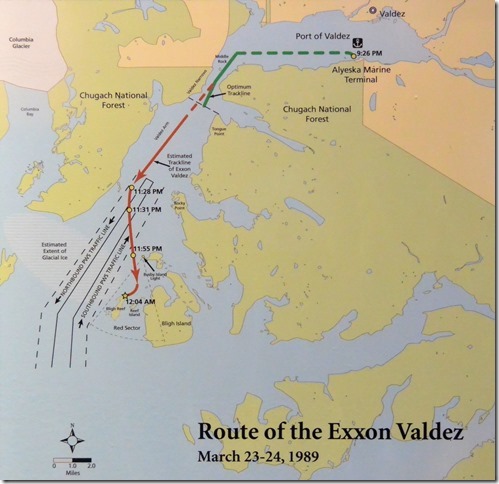
There are volumes to be told about what happened that night, and what has happened since. Cleanup took place over many years, and many say is still on-going. But in truth, it’s only a small part of the history and substance of this small seaport town.
Today, Prince William Sound has, at least in large part, recovered from what was at the time a catastrophic oil spill. (Sadly, it’s not even on the world’s top-50 events today.) Our tour of the Sound, and Columbia Glacier, on the Lu-Lu Belle was extraordinary, and no trace of the damage even occurred to us during that wonderful day. (See my previous post HERE for the entire story.)
It’s difficult for me to write about Valdez, because the town itself is not a visually spectacular destination. But for sure, it has some spectacular history – the infamous spill was preceded by the devastating 1964 earthquake that literally destroyed the town (9.2, strongest ever recorded in North America). And the inception of Valdez, a tiny tent-camp of gold-seekers, matches the histories of many of the hardy towns of the North.
In fact, Valdez is a town of contrasts, of sharp history and gentle presence. Its plain appearance along the shoreline is radically different from the in-your-face beauty of the surrounding mountains, glaciers,, and streams. And, for a small town, it’s fairly diverse. It has a robust harbor, nearby glacier kayaking and hiking, a truly remarkable salmon hatchery, and the usual gaggle of tourist treats like museums, tours, and other essentials. Perhaps most remarkably, Valdez has remained as the functioning terminus of the magnificent Alaska Pipeline. Despite its debacle, or perhaps because of it, Valdez has become internationally noteworthy by being a full-functioning oil port surrounded by a substantial and thriving marine wildlife ecosystem.
SCENIC RIDE Firstly, the approach: there’s only one road to Valdez, the Richardson Highway, and the last 30 miles into town would rank in the top of any scenic byway list. Towering rocky peaks, capped by massive, creeping glaciers, trickling down into splendid waterfalls and gray braided rivers – it’s a fabulous way to get introduced to the town.
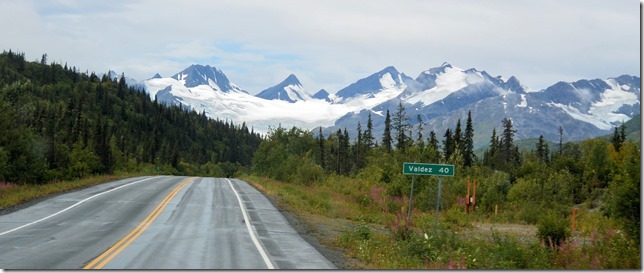
Bridal Veil Falls and Horsetail Falls in the Keystone Canyon area – – –
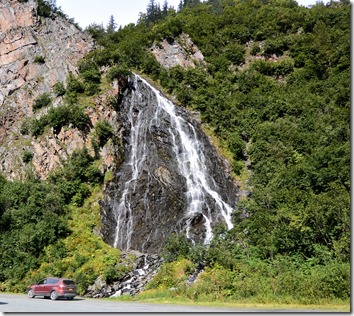
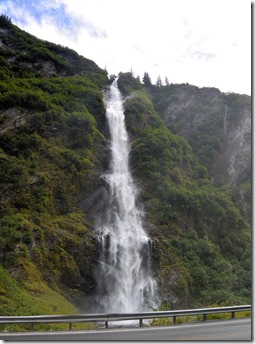
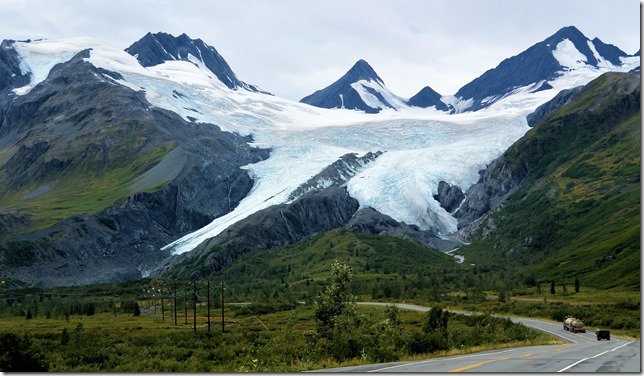
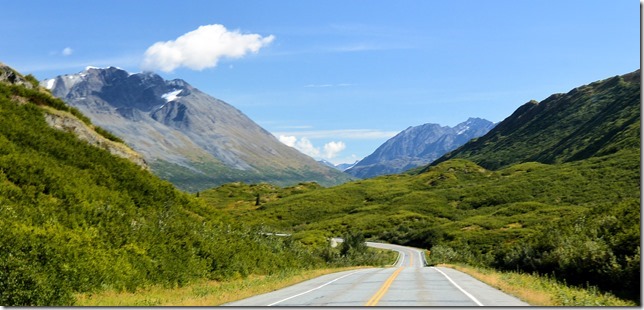
The town itself is neat and tidy, but about as scenic as a box of Kleenex. I don’t know if I took one picture of the town proper. Oh, there were the nice homes back on the hillsides, but generally nothing all that photogenic. A Dawson City it’s not. The Old Town, now – that’s a different story. Old Town is where Valdez was originally built, before the 1964 quake wiped it out. Turns out the ground there was simply moist gravel; when the quake shook it, it simply liquefied. When they decided to re-build, a good bedrock site was chosen about four miles away, and that’s where Valdez exists today. (Museum photo) The oil port didn’t exist back then – – it would be at the right-hand edge of the picture.
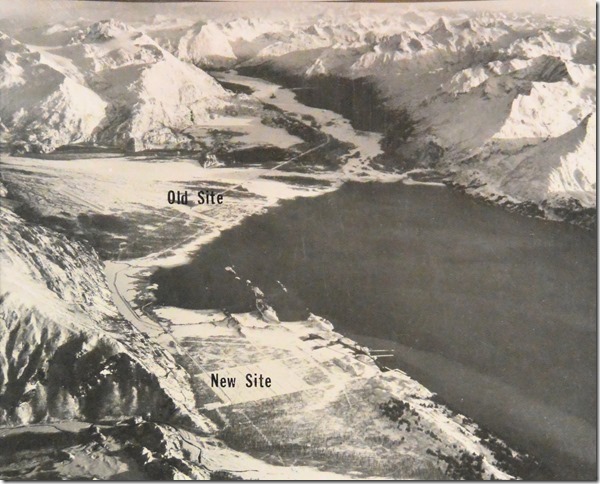
OLD TOWN There’s not much left of Old Town. Anything that could be saved after the quake was moved, and the rest was burned. The deeply sad part of that story was the dock disaster. A ship was in port, and the sailors were tossing treats and candies to the kids on the dock in time-honored tradition. The quake and its tsunami wave dropped the entire dock and shoreline beneath the water, swung the ship in towards land, and dropped the ship on the submerged dock. Thirty-two men, women, and children were killed in a heartbeat. Then, just as capriciously, the next wave un-beached the ship and washed it out to sea, not a man harmed. Go figure.
These days, the old pilings are all that remain, pointing out to the calm bay and a few working boats. There are no plaques or markers to be seen. Maybe the tricky soil won’t support them, or perhaps it’s just too painful.
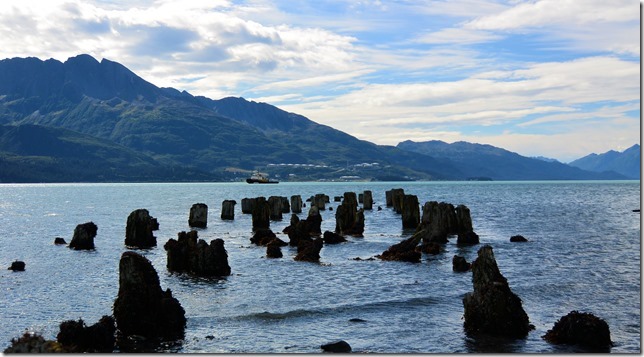
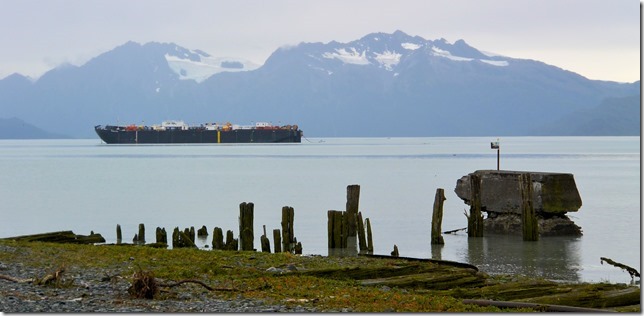
The old oil storage tanks are cut up and rusting, decorated with graffiti, next to a remnant of the old dock.
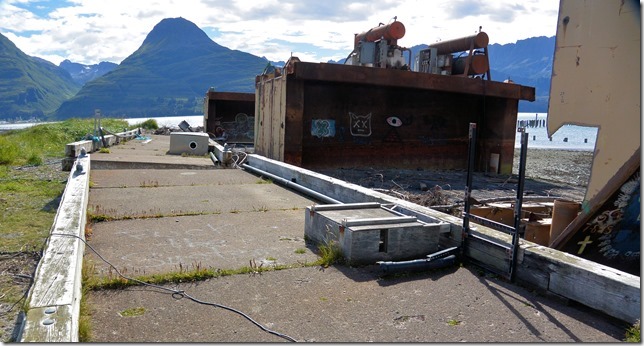
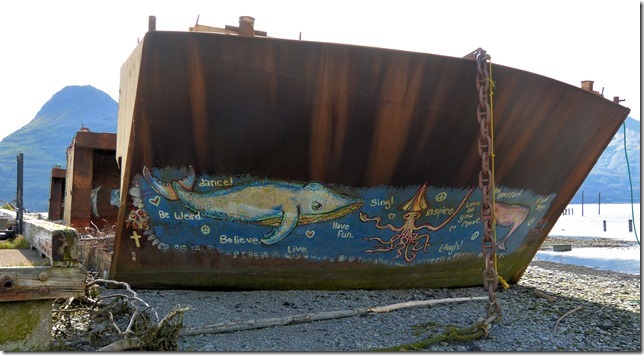
The rest of Old Town is nearly invisible in newly-grown brush and trees. Occasional small tracks lead to nowhere, disappearing into the big braided river.
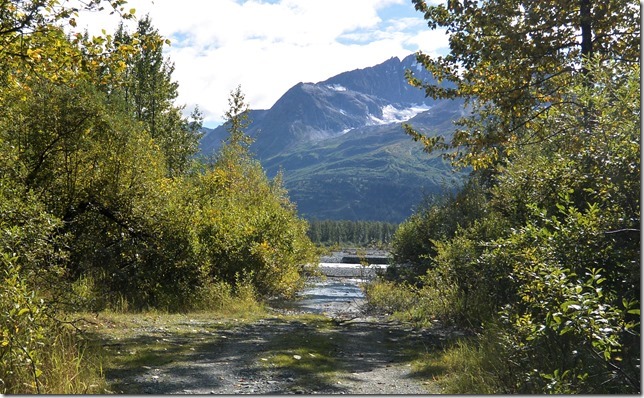
The river’s glacier-fed gray waters flow implacably on by, oblivious to the passage of time and human events.
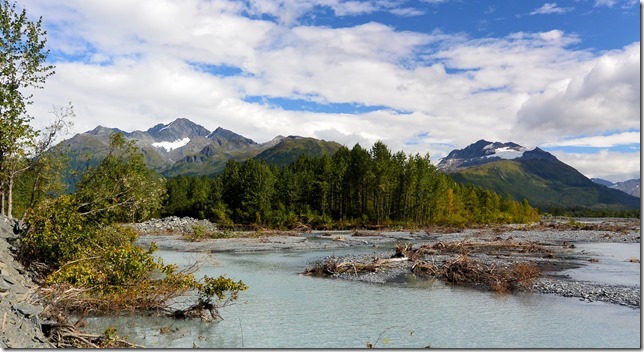
OIL PORT Quiet and unobtrusive, the tank farm and supporting surrounds are on the far side of the inlet from the town proper. Not that it would make a difference if a spill occurred; the 1989 spill coated the entire southwestern shoreline of Prince William Sound. But here, the “heavy industry” is not in the face of the tourists or the townspeople.
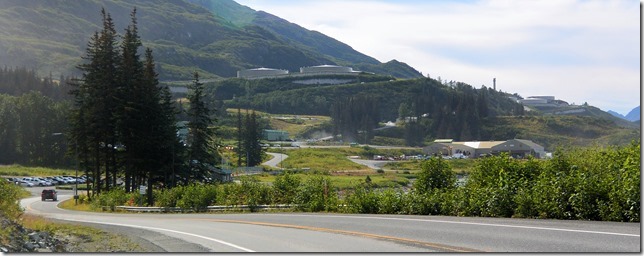
MUSEUM By this time, three months into our trip, Karin and I have visited innumerable towns large and small, with seemingly countless museums. Truth be told, we’re kind of overdosed on museums. But we went anyway to the Valdez Museum, and we were amazed at how interesting and pleasant an experience it was. It’s hard to say exactly why – there were the same dusty showcases full of artifacts and what-not. Perhaps it was the diversity – the exhibits ranged from pre-historic to post-oil-spill. For whatever reasons, we found it well worth the visit, and educational to boot. You’ve already seen a couple of pix previously. Here are a few more highlights:
A great collection of pictures of the old roadhouses, used for overnight lodging by the aspiring miners as they trekked to the gold fields.
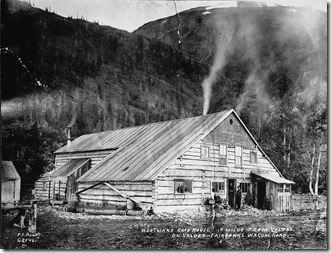
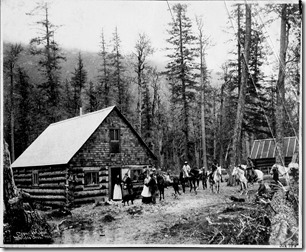
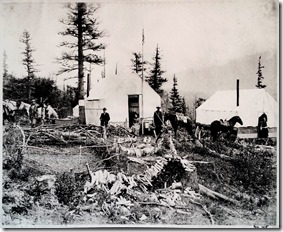
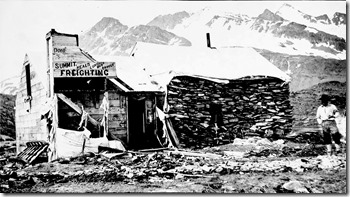
Did you know that the Natives made foul-weather gear out of seal intestines? Me neither. It’s super-lightweight, transparent, and hand-stitched.
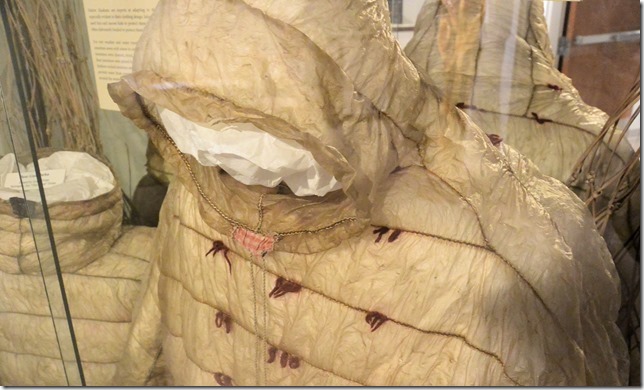
The original bar from the neighborhood gathering-spot in Old Town.
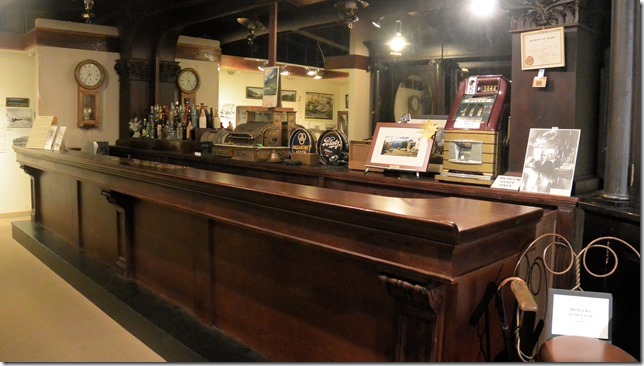
And this gorgeous old steam-powered fire engine, fully restored.
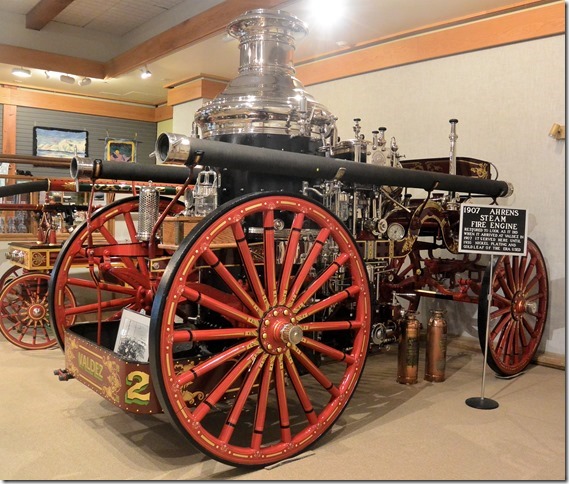
GLACIER PADDLE Valdez even has its very own glacier and lake, just a few miles out of town. They are reachable by road, which means it was easy to take Bote, our inflatable kayak, and have a paddle around the icy waters. No, it wasn’t quite the caliber of our Bear Glacier kayak trip (see that post HERE), but it was easy and fun. This particular glacier is very calm and inactive, and paddling right up to (most of) the icebergs was very safe to do. Cold, though.
As we paddled away from the parking lot, a tired old iceberg, wind- and rain-weathered, got our attention.
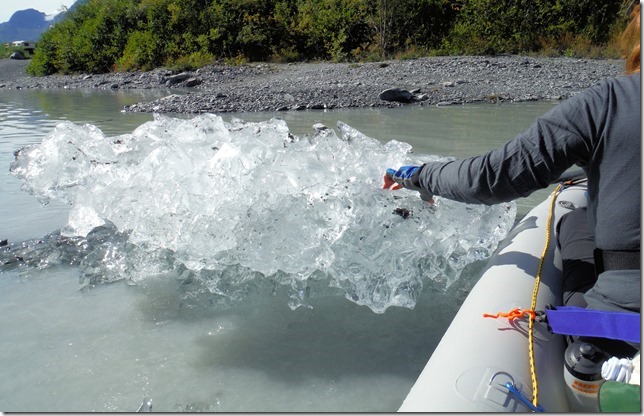
We crossed paths with a tour group of kayakers. They went to our left, while we headed over behind them, to the stream mouth for a lunch break.
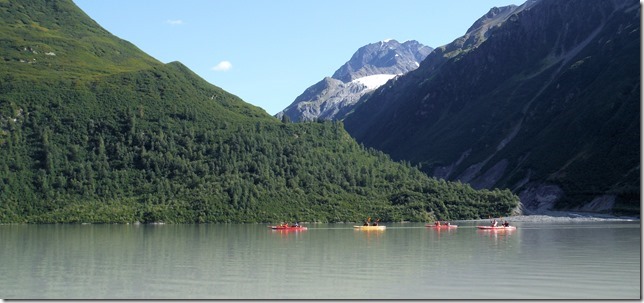
After a brief snack, I took Bote out for a short solo paddle. Got a little frisky in the stream flow and shipped some water on-board.
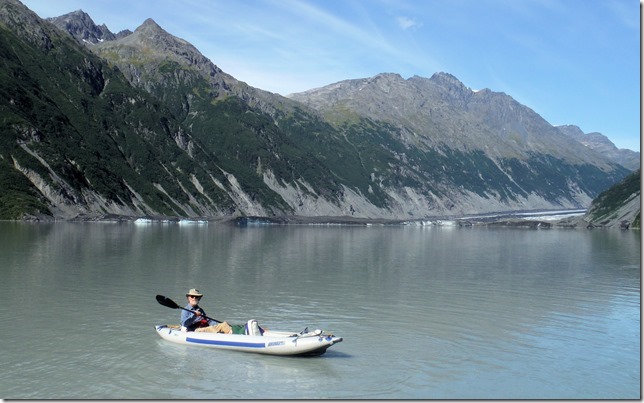
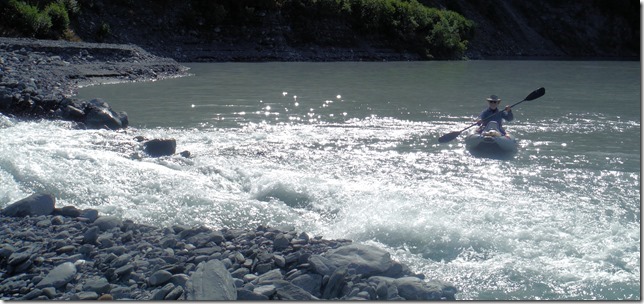
Some areas were tempting to go get a closer look – – but our experience on Bear Glacier taught us not to trust these guys, even the apparently placid ones here. We could hear the tiny cracking and gurgling sounds coming from within ALL of the icebergs we paddled past, so we knew very well they were constantly changing. We stayed well clear of anything that could swamp us.
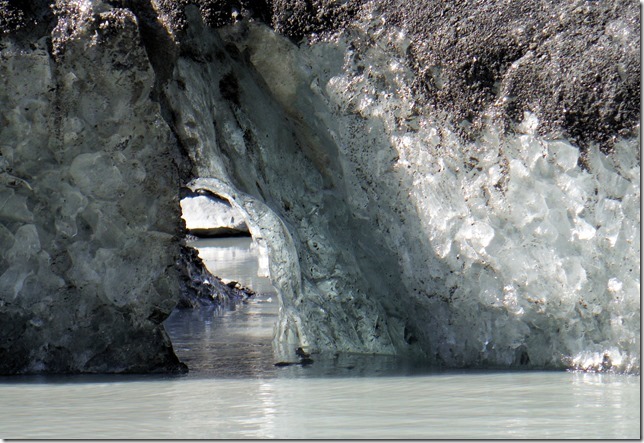
Up at the toe of the glacier, there are several ice-fjords that travel hundreds of yards back into the ice field. Most are well-melted, stable mounds with little undercut or cracking, so we poked Bote up into a couple of them for a closer look.
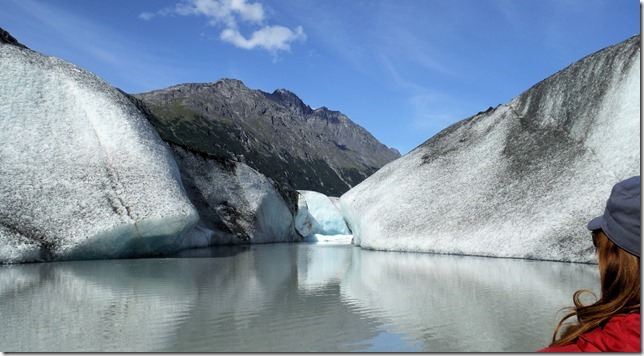
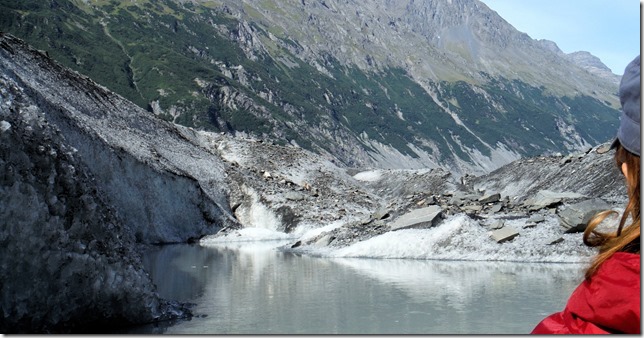
But we definitely stayed out of caves like this one.
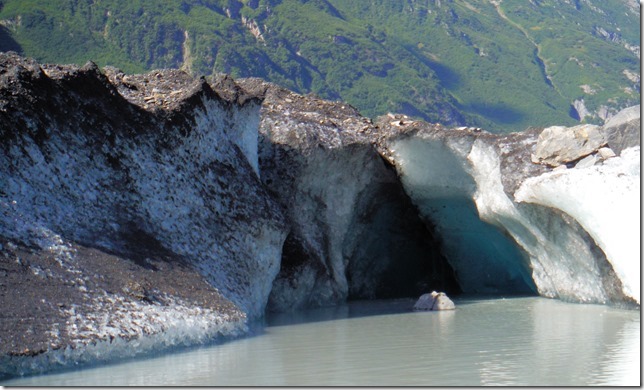
But I’ll tell you, even on a bright sunny day it was COLD paddling around all that ice. When we pulled away from the glacier and headed back to the shoreline and parking lot, it felt pretty good to get warmed up again. We hauled Bote out, deflated everything and headed on back to camp. It was a nice little jaunt.
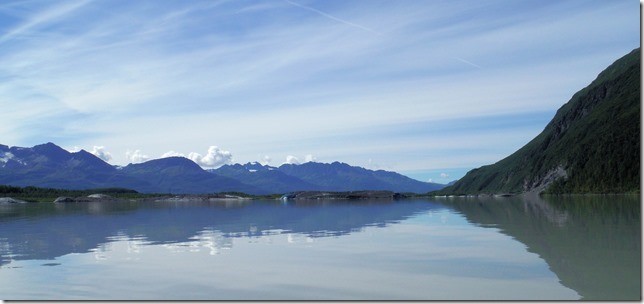
HATCHERY We were going to pass by the fish hatchery, having visited quite a few in our time. Big tanks, lots of fish, seen it before, right? Nope. This one was really different. The fish hatchery here is designed as a salmon spawning source. To get the eggs for a new batch of fish, salmon which were born in this hatchery must return from the open sea and spawn again within the controlled environment of the hatchery. This is accomplished very well, to the tune of 10 million salmon a year, with a fair amount of concrete, steel, and ingenuity.
The first thing that jumped out at us was the fish (duh). But not the fish in the hatchery, the fish trying to get in to the hatchery. This is the huge difference with this place – it relies on returning salmon for next season’s hatch. And return they do, biologically programmed to follow the faint scent of their birthplace waters. They are so thick at the mouth of the hatchery creek that it looks like you could walk across their backs.
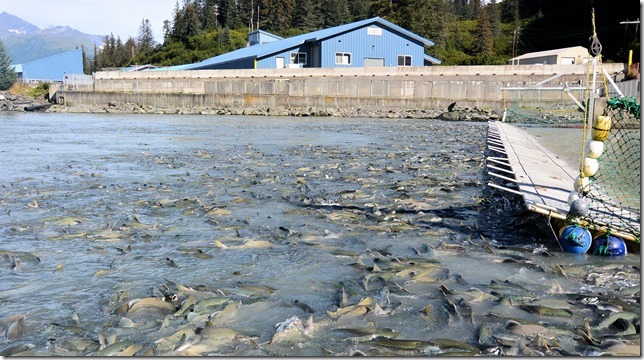
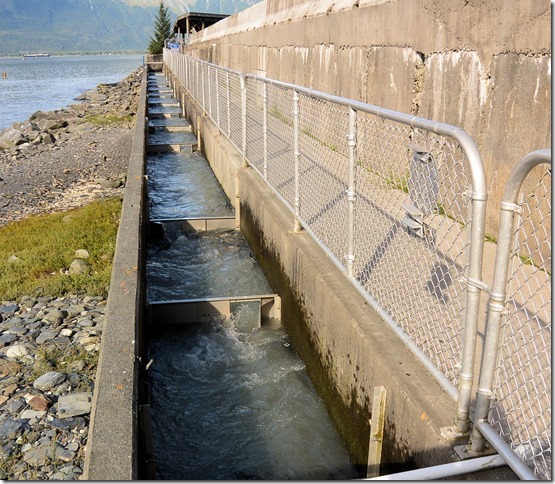
After being diverted from the nearby stream, the fish enter the hatchery environment and run a gauntlet of fish ladders, energetically finning up the fast-flowing stream. They have to do this before they will spawn.
When they get into the hatchery, they’re literally “herded” down long channels until they reach the spawning building.
These guys used long poles that looked like an over-grown toilet plunger. The cup makes a lot of noise and bubbles when it hits the water, and the fish are startled and move away from the disturbance. Fish-herding made simple.
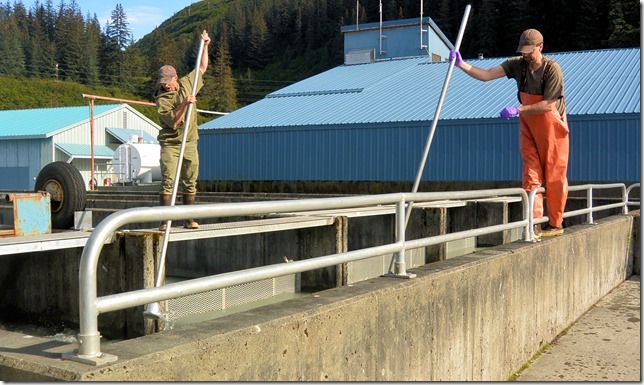
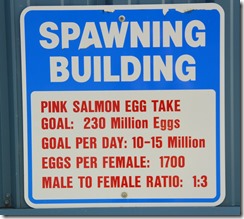 The daily “take” is mind-boggling. Millions upon millions of eggs are nurtured to produce next year’s crop of fish.
The daily “take” is mind-boggling. Millions upon millions of eggs are nurtured to produce next year’s crop of fish.
There’s a lot of competition out there, and large numbers of fish use up their energy before even entering the hatchery or a stream. The shore is littered with carcasses. A local tells us that this is the time of year when Valdez doesn’t smell all that good – but fortunately, most of the salmon runs are taking place far from the township.
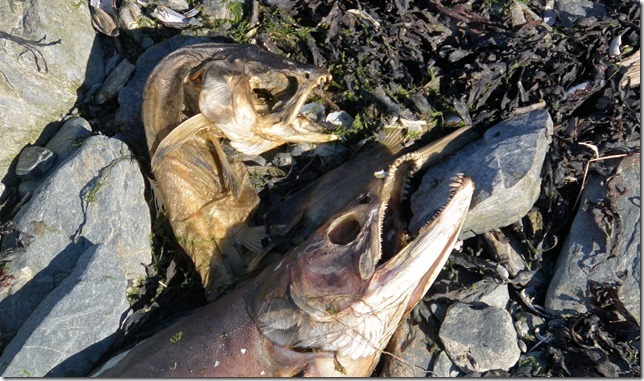
With all the fish around, alive and dead, the seagulls are represented in force. Any feasible ledge makes for a rookery to raise some chicks on the ample feed.
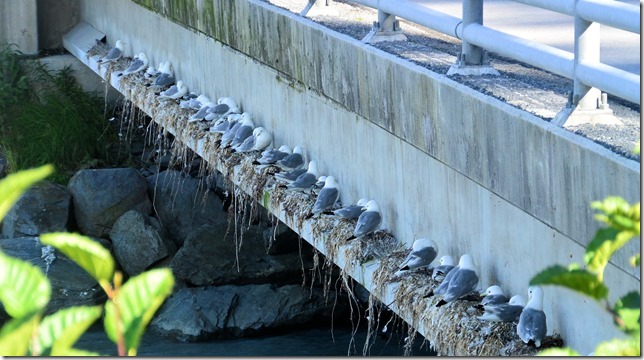
At a nearby stream, the salmon are equally plentiful, and a mama black bear teaches her cubs the art of living off the land. The fish are so dense, she needed only to put her mouth in the water and bite. Lazy day for mama, but then she has one hard winter coming up.
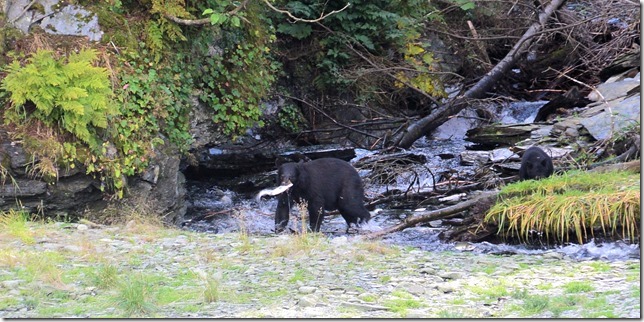
Tomorrow, we head (again) in the general direction of home. It’s late August, which is Autumn up here, and leaves and hillsides are yellowing everywhere. The air is turning crisp and cool, and we know we have to beat-feet to escape the coming snows.
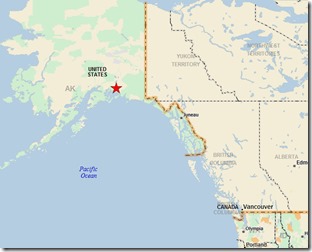
- Miles driven (Howie): 6,946
- Miles driven (Ralph): 3,116
- Days traveling: 104
- Miles from home: 3,045

A wonderful tale, its nice to hear such. I am of course biased, being the second son. I spent two seasons up there trying to learn what he does so effortlessly. I was OK even good, but I was a candle to Dad. You had a good day there, makes me truly miss it. Thank you for the time you put into it. May you have many more such trips.
Sincerely,
Tony Rodolf
Great post Greg,
I love the pictures and commentary. You guys are certainly covering a lot of ground this summer.
Pete